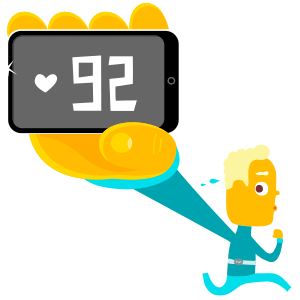Gauge how hard you’re working out to get the most from your workouts and maximize your fitness gains. If you’re going to exercise, you want to know you’re getting the best results that you can for the effort, time and sweat you’re putting into it.
Exercising at the right intensity will prevent you from exercising too hard or not hard enough, and help ensure you achieve your goals.
So what’s exercise intensity? Exercise intensity is related to how hard an activity feels to you. More specifically exercise intensity can be measured using heart rate, but also by how hard you’re breathing, whether you’re sweating, and how tired your muscles feel.
Whether you use high tech or no tech, there are a number ways in which you can measure exercise intensity, and most of them are pretty simple.
Read more: How hard you should exercise?

HEART RATE
Heart rate is a great way to determine exercise intensity, because it’s not subjective.
How it works: Your heart drives blood around your body. The harder you exercise, the greater the demand for oxygenated blood, and therefore the higher your heart rate will be.
Because your heart responds to exercise in a very predictable way, you can use your heart rate to monitor exercise intensity.
To effectively monitor heart rate you need to calculate your maximum heart rate and then base your workouts around training zones. These training zones are expressed as percentages of maximum heart rate (HR max).
Below is a popular method of categorizing effort, which is made up of 5 zones:
- Recovery Zone: 50-60% of HR max
- Fitness Zone: 60-70% of HR max
- Aerobic Zone: 70–80% of HR max
- Lactate threshold: 80–90% of HR max
- Anaerobic Zone: 90–100% of HR max
You can also use a simpler method, in which effort is simply divided into two broad categories:
- Moderate intensity: 50-70% of HR max
- Vigorous intensity: 70-85% of HR max
You can measure your heart rate by using a heart rate monitor, taking your pulse at your wrist or neck, or using the sensors built in to cardio exercise equipment.
Good for: Particularly good for recovery workouts to avoid exercising too hard and prevent overtraining. Also, great for fine-tuning training.
Limitations: Does not work well for HIIT training, in which you alternate short bouts of high intensity exercise with recovery intervals. Also, heart rate can be affected by external stressors such as lack of sleep, stress, or caffeine.
Read more: Heart rate training zones

THE TALK TEST
The talk test is one of the most popular, simple and convenient methods of gauging exercise intensity.
How it works: Talking is reliant on your ability to breathe — specifically exhale. When you exercise your breathing rate increases as your need for oxygen increases. The faster your breathing rate, the harder it is to talk.
The talk test works on this premise – the harder you exercise, the harder it is to talk. So, by simply monitoring that, you can gauge whether you’re exercising at low, moderate, or high intensity.
- Recovery & Fitness Zone: carry on a conversation.
- Aerobic Zone: speak in short sentences.
- Lactate threshold: utter single words.
- Anaerobic Zone: grunting, unable to speak.
Next time you are working out, try chatting to a friend and monitor your speech patterns. If you can tell them where you are going for your holiday, and what you’re going to pack, wear, see and do without pausing for breath you probably exercising below the aerobic zone.
If you are reduced to single words, you are probably exercising in the lactate threshold zone.
Generally, most training is done in the aerobic zone. You should be able to comfortably carry on a conversation by speaking in short sentences. It takes a little bit more work, but it’s not uncomfortable. This is often referred to as the sweet spot of cardiovascular training.
Limitations: Reliable for measuring intensity when you are exercising within your optimal aerobic zone (65% – 80% of maximum heart rate). For your workouts outside this zone, other techniques of monitoring intensity are useful.

BREATHING PATTERN
How it works: When you perform aerobic exercise such as jogging or rowing, your muscles use more oxygen and produce carbon dioxide. Carbon dioxide levels are monitored by chemoreceptors in your blood vessels which send messages to your lungs via your brain to increase the speed and depth of your breathing.
As you increase the intensity of your workout, you switch from nose breathing to mouth breathing. This is (or was because now you’ll be looking for it!) an automatic response to the increased demand for oxygen and occurs at around 60% of your maximum heart rate.
- Recovery Zone: can breathe through your nose
- Fitness Zone: start to breathe through your mouth
- Aerobic Zone: breathing is more labored
- Lactate threshold: breathing is heavy, difficult and uncomfortable
- Anaerobic Zone: gasping for breath
Bottom line – if you are breathing through your nose when doing your cardio, you’re probably in your recovery training zone.

APPEARANCE
Like a bad gambler, you have an exercise “tell”. You may go red, sweat at a certain exercise intensity, develop an intense “thousand yard stare”, clench your fists or exhibit a host of other signs that happen when you hit your training sweet spot.
Once you know what your “tells” are, you can use them to monitor the intensity of your workout.
This method, like breathing above, is a subconscious indicator of how you are feeling. But now, because you are aware of it, you need to relax and just “let it happen”.

RATING OF PERCEIVED EXERTION
– HOW IT FEELS –
Attributed to Swede Gunner Borg, the rating of perceived exertion scale, or RPE for short, is a method of monitoring intensity based on how you feel while exercising.
Rating your perceived exertion involves assessing how physically and mentally difficult a workout feels to you – not about how it should feel. It’s as simple as how easy or hard the exercise feels to you at any given moment on a scale of 1 to 10. And it is completely subjective.
It requires you take notice of you body, such as how hard you’re breathing, how your muscles feel, and how much you’re sweating.
RPE reflects your body’s actual reaction to what you are doing. In other words, it takes external and internal variables into consideration. That means it allows you to adjust workout according to how you feel on a particular day:
- External stressors (e.g. lack of sleep, poor nutrition, medication, caffeine or dehydration) that may negatively impact your performance and make your body work harder, are taken into consideration. So that might mean you make your workout easier to prevent yourself from overworking. Or it may teach you to become more comfortable exercising at certain training targets that you find uncomfortable.
- Fitness gains are factored in. As your fitness levels improve, you can do more (e.g. run or cycle faster), though the perceived effort stays the same. In other words, what felt like an 8 when you started running (maybe jogging for 3 minutes continuously), will feel different after say, 6 months of running (e.g. a tempo run)
Although RPE might seem unscientific at first glance, it is much used by elite athletes and allows you to turn things up a notch when exercise feel easy, and dial it back when you start to get winded.
The RPE Scale
Borg’s original scale runs from 6 to 20 which may seem a little odd. That’s because the original scale was linked heart rate, so his athletes wouldn’t have to monitor their pulses. They would be able to exercise at a particular heart rate, by simply “knocking off” a zero to determine RPE.
For example, if Borg wanted his athletes to work out at 140 bpm, they would simply exercise at level 14 RPE.
With practice, using Borg’s scale can be very precise. However, some users find the concept of a 6-20 scale off-putting and, as a result, a modified version of Borg’s scale emerged. Many users find this modified 0-10 scale far more logical and user friendly.
How to Use RPE
To get this scale clear in your mind, imagine level zero is equal to sitting at home, feet up, watching TV whilst level ten is sprinting after a bus that just won’t stop.
A disadvantage of perceived exertion is that it doesn’t take into account exercise discomfort tolerance. If you find a particular activity uncomfortable, you will probably perceive that you are working harder than you actually are. Also, RPE is totally subjective and it’s not always easy to make completely honest self-judgements. However, RPE is still an incredibly valuable tool that can really boost your fitness gains.
Therefore, think of RPE as an additional layer of monitoring to better inform your training. Combine RPE with the other techniques described above, to accurately estimate how intensely you’re exercising.
By combining the talk test, observing breathing patterns and using RPE, you should be able to get yourself into the appropriate heart rate training zone without having to use a heart rate monitor.
The table below summarizes RPE, the talk test, breathing pattern, and heart rate training.
| RPE | Exertion | %MHR* | How it Feels |
|---|---|---|---|
| 0 | None | <60 | Complete rest. |
| 1 | Very, very easy | <60 | Normal breathing Light household chores. |
| 2 | Very easy | <60 | Normal breathing Moving, but doesn’t feel quite like exercise. |
| 3 | Easy | <60 | Breathing slightly elevated Just about feels like exercise |
| 4 | Moderate | 60-65 | Noticeable faster breathing, full conversation More purposeful exercise. Feels like a workout you could sustain a long time. |
| 5 | Somewhat hard | 70 | Heavy breathing, shorter conversation Feels like a good workout, could do it for an hour. |
| 6 | Hard | 75 | Very heavy breathing, can talk in sentences Challenging but sustainable, could do it for 30 to 40 minutes. |
| 7 | Hard | 80 | Short of breath, short sentences only Feels tough and uncomfortable. Can keep steady pace, but not sure how long. |
| 8 | Very hard | 85 | Short of breath, single words only Really tough, can’t keep this up for long. |
| 9 | Very, very hard | 90-95 | Out of breath, difficult to talk Almost flat out. Counting down the seconds for it to be over. |
| 10 | Maximum effort | 100 | Gasping for breath, grunting Absolute limit. Running like your life depends on it. Feels like you might want to throw up. |
*Approximate % of maximum heart rate (MHR)
RPE is simply another tool in your arsenal. It requires and reminds you to trust your body and to become familiar with yourself. Not to blindly trust high-tech tools, which can be imperfect and only tell part of the story.
Using multiple methods gives you a bigger, more holistic and therefore more accurate picture of your training. Heart rate monitoring is best used in combination with other techniques and not in isolation. Indeed, you can use a heart rate monitor to help you become more accurate at gauging RPE.
The more you monitor your RPE, the better you’ll get at determining it precisely and the better you can optimise your training.

